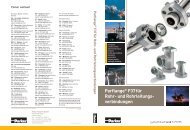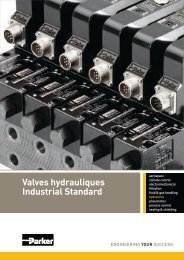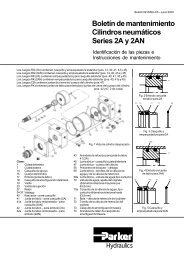Vaporizable Dielectric Fluid Cooling of IGBT Power Semiconductors ...
Vaporizable Dielectric Fluid Cooling of IGBT Power Semiconductors ...
Vaporizable Dielectric Fluid Cooling of IGBT Power Semiconductors ...
Create successful ePaper yourself
Turn your PDF publications into a flip-book with our unique Google optimized e-Paper software.
Figure 2. Example <strong>of</strong> system-level VDF operation model for 3kW heat load at<br />
cold plate and given ambient temperature, showing calculated liquid flow rate<br />
and die and cold plate temperatures.<br />
large reduction in flow rate in the VDF system. A comparison<br />
may be drawn as a calculation demonstrates (Table 1) the<br />
lower flow rate required for a vaporizable system in<br />
comparison to water. The value <strong>of</strong> lower fluid flow rate for<br />
system design is: use <strong>of</strong> a smaller pump, smaller reservoir,<br />
smaller volume <strong>of</strong> fluid, and smaller tube diameters and other<br />
components throughout the cooling system. This is a potential<br />
cost reduction for components as compared to those required<br />
for a water system providing an equal heat dissipation task.<br />
Smaller component sizes and volume <strong>of</strong> fluid result in<br />
reduced system weight and overall physical volume, important<br />
in many areas for power semiconductor applications. Reduced<br />
coolant system size may mean reductions can be achieved in<br />
other mechanical system components, including sheet metal<br />
and other enclosure components.<br />
C. VDF <strong>Cooling</strong> System Design Characteristics<br />
Ambient temperature changes with a two-phase system can<br />
be compensated for in system operation, where the pressure<br />
and temperature are allowed to “float” relative to ambient<br />
conditions. Normal system design procedures are to design for<br />
a maximum system power load, at maximum anticipated<br />
ambient conditions; system pressure and fluid temperature<br />
follow known physical properties <strong>of</strong> the fluids. For a given<br />
system pressure, the resultant fluid temperature may be found<br />
from a reference chart <strong>of</strong> fluid properties.<br />
An overall system design target is to select a vapor quality<br />
maximum value, at the exit <strong>of</strong> the liquid cold plate; a typical<br />
value is 70% vapor quality at exit. [Vapor quality refers to the<br />
ratio <strong>of</strong> vapor to total fluid (70% <strong>of</strong> the total fluid is vapor in<br />
this example.)] Setting a maximum vapor quality value is an<br />
important system safety requirement, to prevent so-called “dryout”<br />
from occurring within the liquid cold plate.<br />
The self-optimizing characteristic <strong>of</strong> these systems has been<br />
identified previously. This is an important attribute for system<br />
control mechanisms.<br />
An important system design requirement is to design for<br />
100% liquid return to the pump inlet, to maximize pump<br />
performance operating life. This target is met by specifying a<br />
minimum condenser capacity for the system, maintaining a<br />
proper gravity return to the pump, and placement <strong>of</strong><br />
components to ensure proper system operation.





